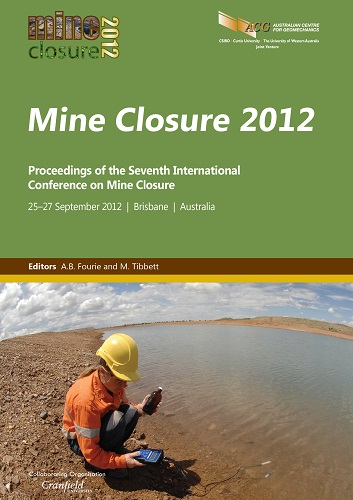Indigenous perspectives on closure and abandonment of mines and oil wells

|
Authors: Smith, HD |
DOI https://doi.org/10.36487/ACG_rep/1208_54_Smith
Cite As:
Smith, HD 2012, 'Indigenous perspectives on closure and abandonment of mines and oil wells', in AB Fourie & M Tibbett (eds), Mine Closure 2012: Proceedings of the Seventh International Conference on Mine Closure, Australian Centre for Geomechanics, Perth, pp. 641-649, https://doi.org/10.36487/ACG_rep/1208_54_Smith
Abstract:
The past five years has shown a massive increase in exploration for minerals, oil and gas in the on-shore and offshore areas of Australia’s Northern Territory. Although many Aborigines are now quite familiar with land-based mining, proposals to mine the seafloor or use reservoir stimulation (hydraulic fracturing) for production of oil and gas are relatively new to them. Aboriginal perceptions of mine closure are affected by historical practices that have led to a number of legacy sites and there is consequently a developing concern that further environmental degradation will also result from modern practices and techniques. This paper primarily seeks to discuss the rationale behind Aboriginal concerns and examines standards currently applied to mine closure and well abandonment. The outcomes are placed in the context of Aboriginal cultural and ecological knowledge; and the inclusion of improved standards for closure in Agreements related to mining and oil and gas production in the Northern Territory is discussed.
References:
ANZECC & ARMCANZ (2000) Australian and New Zealand Environment and Conservation Council; Agriculture and Resource Management Council of Australia and New Zealand. National Water Quality Management Strategy, Guidelines for Fresh and Marine Water Quality, Paper No. 4, Volume 1, The Guidelines, Canberra.
Charles Darwin University (2009) Human Research Ethics Committee Guidelines 2009, Adapted from: Part 1 of Human Ethics Committee Guidelines for completing the application form for ethical clearance, 9 p., viewed 05/07/2012,
Commonwealth of Australia (1997) Senate Uranium Mining and Milling Committee report on its inquiry into uranium mining and milling in Australia, Canberra, Australia.
Commonwealth of Australia (2006) Mine Closure and Completion – Leading Practice Sustainable Development Program for the Mining Industry, Commonwealth of Australia, Canberra, Australia, 2006.
Commonwealth of Australia (2009) Senate Hansard, 9 September 2009, p. 25.
Ecoz Environmental Services (2009) Redbank Copper Environmental Impact Statement, Darwin, 2009.
Ernst, T.M. (2004) Land, Stories and Resources: Some impacts of large-scale resource exploitation on Onabasulu lifeworlds, in mining and Indigenous Lifeworlds in Australia and Papua New Guinea, A. Rumsey and J. Weiner (eds), Sean-Kingston Publishing, Wantage, Oxfordshire, England, pp. 125–135.
Goode, B. and Irvine, C. (2003) South-west Yarragadee: Blackwood groundwater area – Aboriginal cultural values survey, Brad Goode and Associates, Dunsborough, Australia.
Keen, I. (2004) The old airforce road: History, myth and mining in north-east Arnhem land, in mining and Indigenous lifeworlds in Australia and Papua New Guinea, A. Rumsey and J. Weiner (eds), Sean-Kingston Publishing, Wantage, Oxfordshire, England, pp. 157–181.
Kirsch, S. (2004) Changing views of place and time along the OK Tedi; in mining and Indigenous lifeworlds in Australia and Papua New Guinea, A. Rumsey and J. Weiner (eds), Sean-Kingston Publishing, Wantage, Oxfordshire, England, pp. 182–207.
Langton, M. (2006) Earth, wind, fire and water: the social and spiritual construction of water in Aboriginal societies, B. David, B. Barker and I. McNiven (eds), The Social Archaeology of Australian Indigenous Landscapes, Aboriginal Studies Press Canberra, pp. 19–160.
McDonald, E., Coldrick, B. and Villiers, L. (2005) Study of groundwater-related Aboriginal cultural values on the Gnangara Mound, Western Australia, Estill and Associates, Perth, Australia, 123 p.
Parker, G. (1999) A critical review of acid generation resulting from sulfide oxidation: processes, treatment and control, Occasional Paper No. 11, AMEEF, Melbourne, VIC.
Robertson Geoconsultants (2011) Phase 2 Report – detailed water quality review and preliminary contaminant load estimates, Rum Jungle Mine Site, NT, Report to Department of Resources, Northern Territory Government, February 2011, Report Number 1830002/1.
Rose, D.B. (1996) Nourishing Terrains, Australian Heritage Commission, Canberra, Australia, 95 p.
Smith, H.D. (2008) Application of Aboriginal ecological knowledge to the Environmental Impact Assessment process in Australia’s Northern Territory; A research thesis for the Masters of Tropical Environment Management at Charles Darwin University, November 2008.
Smith, H.D. (2012) Informed consent in Australia’s Northern Territory: Proceedings of the 32nd Conference of the International Association for Impact Assessment, Porto, Portugal.
Solomon, F., Katz, E. and Lovel, R. (2008) Social dimensions of mining: research, policy and practice challenges for the minerals industry in Australia, Resources Policy, Vol. 33, pp. 142–149.
Strang, V. (2004) Poisoning the Rainbow: Mining, pollution and indigenous cosmology in Far North Queensland, in Australia and Papua New Guinea, A. Rumsey and J. Weiner (eds), Sean-Kingston Publishing, Wantage, Oxfordshire, England, pp. 12–30.
Taylor, G., Spain, A., Nefiodovas, A., Timms, G., Kuznetsov, V. and Bennett, J. (2003) Determination of the reasons for deterioration of the Rum Jungle Waste Rock Cover, Australian Centre for Mining Environmental Research, Brisbane, 108 p.
UNESCO (2005) Operational Guidelines for the Implementation of the World Heritage Convention, UNESCO World Heritage Centre, Paris, p. 83.
URS (2010) Final Report: Independent Hydrogeological Review – Tailings Storage Facility, Ranger Uranium Mine, URS, Southbank, Victoria, September 2010, 126 p., plus Appendices.
Yu, S. (1999) Ngapa Kunangkul: Living Water – Report on the Aboriginal cultural values of groundwater in the L Grange Sub-basin, Centre for Anthropological Research, University of Western Australia, Perth, 45 p.
© Copyright 2025, Australian Centre for Geomechanics (ACG), The University of Western Australia. All rights reserved.
View copyright/legal information
Please direct any queries or error reports to repository-acg@uwa.edu.au
View copyright/legal information
Please direct any queries or error reports to repository-acg@uwa.edu.au